UP Board Notes for Class 10 Science Notes Chapter 7 Control And Coordination Learning objectives
After completing this chapter, you will be able to:
- Recognize the need for chemical coordination in plants;
- Describe various tropic movements in plants.
- Discuss the role of plant growth regulators;
- List the major plant hormones and discuss their
Physiological effects in regulating plant growth:
• auxins
• gibberellins
• cytokinins
•abscisic acid
• ethylene
The activities that occur inside our body require proper coordination between the organs. Like animals, plants also need internal coordination for their growth and development. Plants do not have a nervous system, like animals, but they still respond to internal and external changes in the environment around them. Plants can detect changes in light, water, touch, chemicals, and gravity and respond to these changes by the action of hormones. Since plants do not have a nervous system, they use hormones for coordination and response. Therefore, the function of control and coordination in plants is performed by chemical substances called hormones or plant growth regulators.
In this chapter, we shall learn about chemical coordination in plants and how it is brought about.
UP Board Notes for Class 10 Science Notes Chapter 7 Control And Coordination Stimuli And Receptors
If we accidentally touch any hot object, we immediately withdraw our hands. Thus, we respond to changes in our surroundings. Any change in the environment to which an organism responds and reacts is called a stimulus (plural: stimuli). For example, the leaves of touch-me-not plants fold if we touch (stimulus) them.
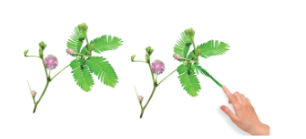
UP Board Notes for Class 10 Science Notes Chapter 7 Control And Coordination Touch-me-not plant (Mimosa pudica)
Stimuli are detected by a group of cells called receptors. For example, our skin, eyes, ears, nose and tongue contain different receptors. Plants and animals respond to stimuli in a different ways. Animals respond to stimuli in many ways because they have a nervous system.
| Class 10 Science | Class 11 Chemistry |
| Class 11 Chemistry | Transformation of Sentences |
| Class 8 Maths | Class 8 Science |
However, plants react to stimuli in a very limited way because they do not have a nervous system. Thus, response to stimuli is a characteristic property of each living organism.
Plant movements in response to stimuli can be of two types:
- Tropic movements
- Nastic movements
UP Board Notes for Class 10 Science Notes Chapter 7 Control And Coordination Tropic movements or tropism
The environment has a great influence on a plant’s shape. A growth response that results in the movement of plant parts towards or away from stimuli is called tropism. In simpler terms, the movement of a plant in the direction of a stimulus is known as tropism. It is of two types-positive tropism and negative tropism.
- When the growing movement of the plant part is towards the stimulus, it is called positive tropism.
- When the growing movement of the plant part is against or away from the stimulus, it is called negative tropism.
The tropic movements are most commonly found in the radially symmetrical plant parts such as roots and stems.
The tropic movements help the plants to obtain water and nutrients from the soil and light from the sun that are necessary for their growth and survival.
UP Board Notes for Class 10 Science Notes Chapter 7 Control And Coordination Types Of Tropical Movements In Plants
There are five types of tropical movements in the plants – phototropism, geotropism, hydrotropism, chemotropism and thigmotropism.
1. Phototropism – Movement in response to light.
The growth and movement (orientation) of a plant part in response to the light is called phototropism. For example, movement of sunflowers in the direction of sunlight is phototropism.
If the plant part (like the shoot/stem) orients towards the light then it shows positive phototropism. If the plant part (like its root) moves away from light then it shows negative phototropism.
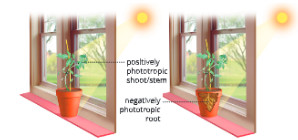
Positive phototropism Negative phototropism
The phototropic movements are controlled by growth-regulatory chemical substances (such as auxins) which collect inside the cells farthest away from the light. This causes the plant cells farthest from light to get elongated, leading to an increase in length towards or away from the light source and resulting in curvature.
2. Geotropism – Movement in response to gravity
The growth movement of a plant part in response to gravitational force of the earth is called geotropism. Roots show positive geotropism (grow in the To show phototropism in plants).
UP Board Notes for Class 10 Science Notes Chapter 7 Control And Coordination Activity 1
To show phototropism in plants.
UP Board Notes for Class 10 Science Notes Chapter 7 Control And Coordination Procedure
- Take a conical flask containing water.
- Take a few freshly germinated bean seeds and suspend these in the conical flask with the help of a loose wire mesh.
- Place the flask in the cardboard box as shown on open side of the box should face the source of light.
- Leave the set-up for 3 days and observe.
UP Board Notes for Class 10 Science Notes Chapter 7 Control And Coordination Observation 1
You will observe that shoots bend towards the light and root away from the light.
- Now, rotate the flask in such a manner that shoots bend away from the light and roots towards the light. Leave the set-up for a few days and observe.
UP Board Notes for Class 10 Science Notes Chapter 7 Control And Coordination Observation 2
You will observe that once again shoots turn towards the light and root away from the light.
UP Board Notes for Class 10 Science Notes Chapter 7 Control And Coordination Conclusion
This shows that the light acts as a stimulus. Shoots respond by bending towards the light (positive phototropism) while roots bend away from the light (negative phototropism).
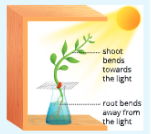
Positive and negative phototropism direction of gravity) while shoots show negative geotropism (grow against a force of gravity). This can be observed if you plant a seedling upside down, the roots tend to grow downwards while the shoot will grow upwards.

Positive and negative geotropism
3. Hydrotropism – Movement in response to water
The growth movement of plant parts towards water or moisture is called hydrotropism. The roots always grow towards water, therefore roots are positively hydrotropic. For example, the roots of plants growing in humid soil bend towards a higher relative humidity level.
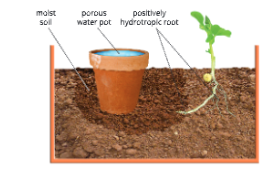
Positive hydrotropism
4. Chemotropism – Movement in Response to Chemicals
The growth movement of a plant part due to chemical stimuli is called chemotropism. For example, a pollen tube grows through the style towards ovules in response to certain chemical secretions from stigma.
When the plant part grows towards chemical stimulus, it is positive chemotropism. If it grows away from chemicals, it is negative chemotropism.
5. Thigmotropism – Movement in Response to Touch
The growth movement of a plant part in response to the touch of an object is called thigmotropism. In some plants, when the plant organ touches support, it results in a coiling response to catch and hold the object and tighten its hold. For example, the tendrils 88 of a plant (such as sweet peas and vines)
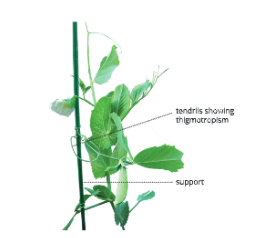
Thigmotropism grows towards support, touch it and wind around that support.
Roots have a negative touch response, which means that when they feel an object, they move and grow away from it. This property allows the roots to go through the soil with minimum resistance.
UP Board Notes for Class 10 Science Notes Chapter 7 Control And Coordination Nastic movements or nasties
The movement of a plant part in response to an external stimulus when occurs in a way that the direction of response is not oriented with respect to the direction of the stimulus, it is called nastic movement.
The curvature so produced in these types of movements is because of diffused stimuli and affects the whole plant uniformly. Nastic movements are temporary movements and plant organs revert after the removal of stimulus.
- When the non-directional movement of a plant part occurs in response to touch, it is called thigmonasty. For example, movement in touch-me-not plant (Mimosa pudica).
- When the non-directional movement of a plant part (usually petals) occurs in response to light, it is called photo nasty. For example, opening and closing of Dandelion flower in response to light intensity.
The main difference between tropic and nastic movements is that a tropic movement is directional while a nastic movement is non-directional.
The difference between thigmotropism and thigmonasty is given in Table.
Table. Differences between thigmotropism and thigmonasty
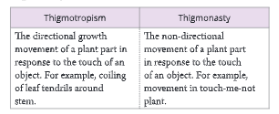
UP Board Notes for Class 10 Science Notes Chapter 7 Control And Coordination- Plant Growth Regulators
Plants produce certain chemical substances in their cells which regulate their growth and development. These chemicals are secreted in very minute quantities but have a substantial effect on physiological processes in a plant.
Some of these chemicals stimulate plant growth while others retard the rate of growth in plants. Therefore, these chemicals are known as plant growth regulators or plant hormones or phytohormones.
They coordinate the activities of the plants by controlling one or the other aspect of growth of the plants.
Types of plant growth regulators
There are five main types of naturally occurring plant hormones or plant growth regulators.
- 1. Auxins
- Gibberellins
- Cytokinins
- Ethylene
- Abscisic acid (ABA)
Auxins
Auxins are a group of plant growth regulators which are synthesized in meristematic tissues at the shoot and root tips. Auxins promote cell enlargement and cell differentiation.
The most common naturally occurring auxin is indole-3-acetic acid (IAA). The common synthetic auxin is indolebutyric acid (IBA). Auxins are widely used in agricultural and horticultural practices due to their role in plant growth.
Functions
1. Influences plant growth: Auxin is a growth hormone and helps the cells to grow longer. It is synthesized at the shoot and root tips. When the tip of a tendril touches a support, the auxin present in it moves away from the support.
Therefore, the side of tendril away from support grows longer and faster. It also curves or bends towards the support and as a result winds around the support.
2. Counter balances root and shoot growth: It has opposite effect on the growth of the stem and roots. It promotes cell growth in shoots and inhibits cell growth in roots.
3. Controls the phototropic behaviour of a plant: When light comes from one side of the plant, auxin diffuses away from the light towards shady side of the shoot. The higher concentration of auxin towards the shady areas stimulates the cells to grow longer and faster and the plant appears to bend towards light.
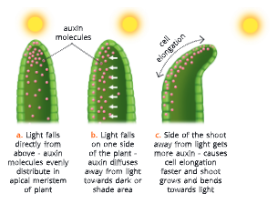
Auxin controls the phototropic behaviour of a plant
4. Controls the geotropic behaviour of a plant: In a root, extra auxin inhibits growth. In a root, which is growing sideways, more auxin gets accumulated on its lower side. Therefore, the cells on the upper side grow and elongate faster. As a result, the root bends downwards.
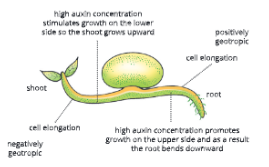
Auxin controls the geotropic behaviour of a plant
5. Controls the hydrotropic behaviour of a plant: In a root, more auxin is produced on the side with more moisture. This inhibits the growth on that side and as a result, the root bends towards the moisture.
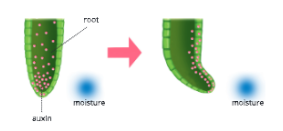
Auxin controls the hydrotropic behaviour of a plant.
6. Induces the formation of seedless fruits without fertilization (known as parthenocarpy) in a number of plants. For example, in tomatoes.
7. Helps in the lengthening of internodes and suppresses the growth of lateral buds.
Gibberellins
Gibberellins are another class of plant growth regulators which produce a variety of physiological responses in plants. These are formed in plastids of leaves of 90 buds, developing embryos and root tips.
At present, more than a hundred different gibberellins have been identified. They are denoted as GA₁, GA₂, GA3 and so on. Of these, gibberellic acid (GA3) is the most thoroughly studied.
Functions
- Gibberellin promotes cell enlargement in the presence of auxins.
- It delays leaf senescence in a few species of plants.
- It promotes cell division and stimulates stem elongation and causes plants to grow taller.
- It stimulates seed germination by breaking seed dormancy.
- It also helps in seed germination, flowering and fruit growth.
- It is used in the brewing industry to speed up the malting process.
Cytokinins
Cytokinins are a kind of plant hormones that play a central role during cell cycle and influence many developmental processes. Natural cytokinins are synthesized in regions where rapid cell division occurs, for example, root apices, developing shoot buds, young fruits, etc.
It also helps to produce new leaves, chloroplasts and lateral shoot growth. Cytokinins are produced in roots and transported up through the xylem. They promote tissue growth, and budding I retard plant senescence.
Functions
- Cytokinin promotes cell division. Therefore, it is present in high concentrations in areas of rapid cell division like fruits and seeds.
- It controls cell enlargement and cell differentiation.
- Like gibberellins, it also helps in breaking seed dormancy.
Ethylene
Ethylene is a growth-regulatory gaseous hormone. It is formed in all parts of plants but its synthesis occurs maximum during the ripening of some fruits.
Functions
- Ethylene is a gaseous hormone that has inhibitory effect on growth.
- It stimulates abscission in flowers and fruits.
- It strongly promotes the formation of female flowers in monoecious plants like pumpkin and melon.
- It induces ripening of fruits.
- It causes downward curvature of leaves (known as epinasty).
- It induces flowering in mango.
- It breaks seed and bud dormancy. It initiates the sprouting of potato tubers and germination in peanut seeds.
Abscisic acid (ABA)
Abscisic acid is a weak acid that was first identified in the early 1960s as a growth inhibitor and was originally believed to be involved in abscission. It is also called a stress hormone as it acts as a mediator in controlling plant responses to environmental stresses. It is produced in mature green leaves and in fruits.
Functions
- Abscisic acid is a growth-inhibiting hormone and inhibitor of plant metabolism.
- It promotes wilting of leaves.
- It promotes the dormancy of seeds and buds. It acts as an inhibitor of seed germination.
- It prevents loss of water by causing stomatal closure.
UP Board Notes for Class 10 Science Notes Chapter 7 Control And Coordination Summary
- Plants do not have a nervous system but they still respond to internal and external changes in the environment around them.
- The function of control and coordination in plants is performed by chemical substances called hormones or plant growth regulators.
- Any change in the environment to which an organism responds and reacts is called a stimulus. Response to stimuli is a characteristic property of each living organism.
- Plant movements in response to stimuli can be of two types: tropic movements and nastic movements.
- A growth response that results in the movement of plant parts towards or away from stimuli is called tropism.
- When the growing movement of the plant part is towards the stimulus, it is called positive tropism. When the growing movement of the plant part is against or away from the stimulus, it is called negative tropism.
- There are five types of tropisms found in the plant phototropism, geotropism, hydrotropism, chemotropism and thigmotropism.
- The growth movement of a plant part in response to the light is called phototropism.
- The growth movement of a plant part in response to gravitational force of the earth is called geotropism.
- The growth movement of a plant part towards water or moisture is called hydrotropism.
- The growth movement of a plant part due to chemical stimuli is called chemotropism.
- The growth movement of a plant part in response to the touch of an object is called thigmotropism.
- The movement of a plant part in response to an external stimulus when occurs in a way that the direction of response is not based on the direction of stimulus, it is called nastic movement.
- Plants produce certain chemical substances in their cells which regulate their growth and development. These chemicals are known as plant growth regulators or plant hormones or phytohormones.
- Auxin is a growth hormone and helps the cells to grow longer, and controls the phototrophic and the geotropic behaviour of a plant.
- Gibberellin promotes cell enlargement, and cell division and stimulates stem elongation
- Cytokinins play a central role during the cell cycle and influence numerous developmental programmes.
- Ethylene is a gaseous hormone that has an inhibitory effect on growth and induces ripening of fruits.
- Abscisic acid is a growth-inhibiting hormone and inhibitor of plant metabolism. It promotes wilting of leaves.
